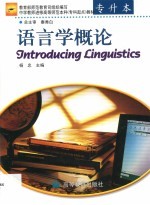
- 作 者:杨忠主编
- 出 版 社:北京:高等教育出版社
- 出版年份:2002
- ISBN:7040115360
- 标注页数:165 页
- PDF页数:173 页
请阅读订购服务说明与试读!
订购服务说明
1、本站所有的书默认都是PDF格式,该格式图书只能阅读和打印,不能再次编辑。
2、除分上下册或者多册的情况下,一般PDF页数一定要大于标注页数才建议下单购买。【本资源173 ≥165页】
图书下载及付费说明
1、所有的电子图书为PDF格式,支持电脑、手机、平板等各类电子设备阅读;可以任意拷贝文件到不同的阅读设备里进行阅读。
2、电子图书在提交订单后一般半小时内处理完成,最晚48小时内处理完成。(非工作日购买会延迟)
3、所有的电子图书都是原书直接扫描方式制作而成。
CHAPTER 1 Language and Linguistics: an Overview 1
1.1 What is language? 1
1.2 Features of human language 2
1.3 Functions of language 5
1.4 Types of language 6
1.5 The myth of language: language origin 8
1.6 Linguistics: the scientific study of language 9
TUTORLAL ACTIVITIES/QUESTIONS 13
MINI-PROJECTS 13
CHAPTER 2 Phonetics: the Study of Speech Sounds 14
2.1 The study of speech sounds 14
2.2 The sound-producing mechanism 14
2.3 Phonetic transcription of speech sounds 16
2.4 Description of English consonants 17
2.5 Description of English vowels 19
2.6 Phonetic features and natural classes 21
TUTORLAL ACTIVITIES/QUESTIONS 22
MINI-PROJECTS 23
CHAPTER 3 Phonology: the Study of Sound Systems and Patterns 24
3.1 The study of sound systems and patterns 24
3.2 Phonemes and allophones 24
3.3 Discovering phonemes 25
3.4 distinctive features and non-distinctive features 27
3.5 Phonological rules 28
3.6 Syllable structure 29
3.7 Sequence of phonemes 30
3.8 features above segments 31
TUTORLAL ACTIVITIES/QUESTIONS 33
MINI-PROJECTS 35
CHAPTER 4 Morphology: the study of Word Structure 36
4.1 Words and word structure 36
4.2 Morpheme: the minimal meaningful unit of language 36
4.3 Classification of morphemes 37
4.4 Formation of English words 38
TUTORLAL ACTIVITIES/QUESTIONS 43
MINI-PROJECTS 44
CHAPTER 5 Syntax: the Analysis of Sentence Structure 45
5.1 Grammaticality 45
5.2 Knowledge of sentence structure 46
5.3 different approaches to syntax 47
5.4 Transformational-generative grammar 49
5.5 Systemic-functional grammar 60
TUTORLAL ACTIVITIES/QUESTIONS 69
MINI-PROJECTS 72
CHAPTER 6 Semantics: the Analysis Meaning 73
6.1 The study of meaning 73
6.2 Reference and sense 74
6.3 Classification of lexical meanings 75
6.4 Lexical sense relations 77
6.5 Describing lexical meaning: componential analysis 80
6.6 Words and concepts 81
6.7 Semantic relations of sentences 83
6.8 Metaphors 85
TUTORLAL ACTIVITIES/QUESTIONS 89
MINI-PROJECTS 92
CHAPTER 7 Pragmatics: the Analysis of Meaning in Context 93
7.1 The pragmatic analysis of meaning 93
7.2 Deixis and reference 94
7.3 speech acts 96
7.4 Cooperation and implicature 98
7.5 The politeness principle 99
7.6 The principle of relevance 101
7.7 conversational structure 103
TUTORLAL ACTIVITIES/QUESTIONS 106
MINI-PROJECTS 107
CHAPTER 8 Language in Social contexts 108
8.1 Sociolinguistic study of language 108
8.2 Varieties of a language 108
8.3 Grades of formality 111
8.4 Languages in contact 112
8.5 Taboos and euphemisms 113
8.6 Language and culture 114
8.7 Communicative competence 116
TUTORLAL ACTIVITIES/QUESTIONS 117
MINI-PROJECTS 117
CHAPTER 9 Second Language Acquisition 118
9.1 What is second language acquisition? 118
9.2 Factors affecting SLA 119
9.3 Analyzing learners language 122
9.4 Explaining second language acquisition 124
TUTORLAL ACTIVITIES/QUESTIONS 127
MINI-PROJECTS 128
CHAPTER 10 Linguistics and Foreign Language Teaching 129
10.1 foreign language teaching as a system 129
10.2 Contribution of linguistics: applications and implications 131
10.3 Linguistic underpinning of syllabus design 132
10.4 Method as integration of theory and practice 133
10.5 Linguistics the professional development of language teachers 136
TUTORLAL ACTIVITIES/QUESTIONS 137
MINI-PROJECTS 139
AppendixⅠ Families/Groups of Languages 140
AppendixⅡ The Indo-European Language Family 142
Bibliography 144
Suggested Solutions to Tutorial Questions 148
An English-Chinese Glossary 156
